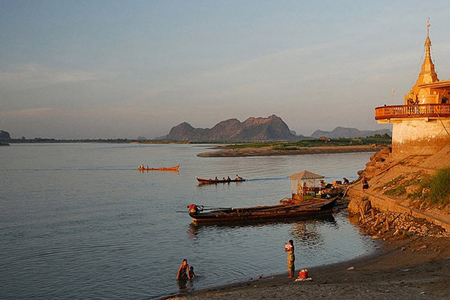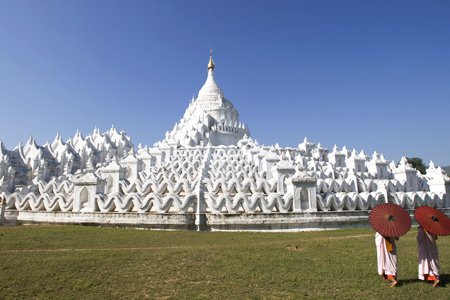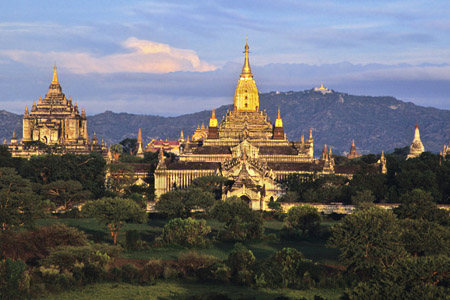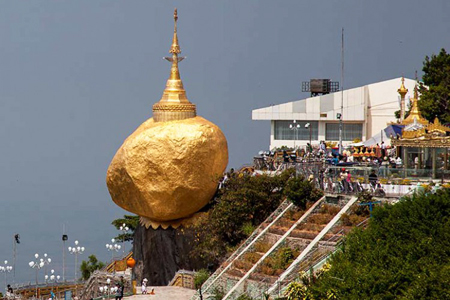Lies on the conjunction of the highway to Hpa An, Thaton is one of the stunning destinations to explore in Burma tours. In the early centuries of the Christian era, the Mons were settled in the region between the Sittang and Than Lwin rivers which were known as the Mon kingdom of Ramannadesa. Thaton (Sudhamma) the seat of this kingdom was also known as Suvannabhumi or the Golden Land which also applies to the whole region of continental South-east Asia around the Bay of Bengal. Tradition ascribes the founding of the city to King Siharaja during the lifetime of Buddha while the Mahavamsa, a Sinhalese chronicle, asserts that a Buddhist mission led by Sona and Uttara was despatched to Suvannabhumi after the third Buddhist Council in the third century B.C. The Kalyani inscription of Dhammazedi, however, identifies Suvannabhumi, the place where the Buddhist mission arrived, with Golamattika or Taikkala which is situated near Ayetthema village at the foot of the Kelasa hills about 30 miles north of Thaton. Doubtless, Thaton was a flourishing port in ancient times and there was constant intercourse between Southern India and the region around Thaton and Bago. Myanmar chronicles mention that Buddhagosa, a native of Thaton made a voyage to Ceylon about 400 A.C. and succeeded in transcribing the Buddhist manuscripts in Mon characters. He is said to have brought over from Ceylon to Myanmar a copy of Kaccayana’s Pali grammar which he translated into his native language and to have written a commentary upon it. The historicity of this personage is doubted by some scholars but the prevalence of Theravada Buddhism in Lower Myanmar by the fifth century' A.C. is evidenced by archaeological and epigraphical finds, so the Mon country also must have by then been influenced by the great faith. When in the middle of the 11th century King Manuha was ruling at Thaton the religion was spreading throughout the land. Shin Arahan, a monk of Thaton well versed in the sacred books of Theravada Buddhism, went to Bagan and converted King Ana wrahta. On his ad\ ice the king of Bagan requested Manuha to present him certain sacred texts and relics. But Manuha considered it unseemly to send the scriptures to one who held false doctrines and flatly refused Anawrahta’s request. Thereupon Anawrahta marched on Thaton, conquered Manuha and took away thirty-two sets of the Tripitaka. With the king taken captive to Bagan, Thaton thenceforth remained under Myanmar domination till the 13th century.

The Mons re-established their independence after the fall of Bagan but the seat of this kingdom, first established at Martaban, was soon after removed to Bago. The old city of Thaton appears to have been built on a quadrangular plan like the more modern cities of Amarapura and Mandalay. There are two ramparts in a rectangular shape and the moat lies between the two walls which are faced with laterite stones. The east and west inner walls are about 7,700 feet long while those on the north and south are 4,000 feet each. In the centre is the citadel or palace site measuring from north to south 1,080 feet, and east to west 1,150 feet. As the present town is developed within the old city the remains of the inner city are no more visible. The chief pagodas are situated between the palace site and the south wall. Now the largest is the Shwezayan pagoda said to have been built in the 5th century B.C. enshrining four tooth-relics of the Buddha. It has been built over and has now assumed a modern shape with a circular base and a bell-shaped superstructure. A notable pagoda nearby is the Thagyapaya or Myatheindan pagoda built entirely of hewn laterite. It consists of three high square terraces and a bell. The lower base is 104 feet square and 18 feet high while the upper terraces are proportionately diminished in size. The third storey and the conical superstructure have been rebuilt and the whole building was renovated from time to time. Projecting from the center of each of the walls below the two upper terraces and facing the cardinal points are deep and high niches adorned with arches. Each of these niches now enshrines a standing image of the Buddha. Besides these high niches, there are smaller ones sunk in the dado below the second terrace to which access is given by four flights of steps. Originally there were embedded in them 64 terracotta plaques bearing bas-reliefs. A large number of them are now missing and those still in their original places are either broken or damaged and have been coated with layers of whitewash, which render the figures almost invisible. However, among the very few reliefs that are still extant scenes illustrating the Vessantara, the Vidhura, the Maha-ummagga or Mahosadha, the Bhuridatta, and the Temiya Jatakas could be identified. These reliefs can be assigned, stylistically, to the 11th-12th century. Within the precincts of the Shwezayan pagoda were found seven inscribed stones, five in early Mon of the 11th century, one medieval and the seventh illegible.

These are now preserved in a tazaung or wat within the compound. Among the stone sculptures collected in the same building is a figure of standing Buddha depicted in bold relief on a sandstone slab. His right hand is hanging on his side with the palm facing outwards in the boon-giving pose, varada mudra. His left hand is held upwards with the fingers in argumentative attitude. On the two sides of the nimbus above the shoulders are two hamsa birds also in relief, facing each other. The sculpture seems to be a prototype of those in the Ananda temple at Bagan and may be ascribed to the 10th-11th century. Across the road outside the pagoda, the compound is the Kalyani Sima built on the remains of an old one. Around that ordination hall may still be seen the boundary pillars in sandstone with stories from the Mahanipata or the Ten Great Jatakas carved in relief. These sculptured pillars belong to the 11th-13th century as evidenced by an inscription on one of them. An earlier type of standing Buddha in bronze was discovered several decades ago by the presiding monk of the Saddhama-jotika monastery of Yanaung- Taik, Thaton. The Dipankara Buddha has the right hand raised in the fear- dispelling attitude (abhaya-mudra), while the left-hand holds a fringe of the robe. The robe closely fits the body but the hem of the drapery stands out in bold folds. The pleats around the waist are visible but the drapery between the legs is indicated by thin lines. Both the shoulders are covered, and the edge of the garment is shown there by a small fold below the neck. This image resembles the one discovered at Sri Ksetra in 1926-27 among other objects belonging to the 7th-8th century. Brahmanical sculptures belonging to the 9th-10th century were also discovered at Thaton. Two slabs of reddish sandstone bear in bold relief the figure of Vishnu reclining on the serpent Ananta. From his body issues, three lotus stems on which are seated Brahma, Vishnu, and Siva. The third sculpture is that of four-armed Siva seated with his vehicle, Nandi, the bull, below his right leg and placing the buffalo- demon under his left knee. Of a little later in date are two small images of Ganesa and a small sculpture of a seated Brahma with three visible heads. These were removed to the Phayre Museum at Yangon (which had no permanent building) and thence loaned to the Yangon University Library. They were badly damaged during the second world war and whatever remained of them in fragments are now shifted to the Archaeological Department. Some of the notable monuments and antiquities in the vicinity of this ancient site deserve mention here.

The ruins of the fort walls of Taikkala, believed to be the earlier city of Suvannabhumi, are still to be seen at the present Ayetthema village. Within this old city is the Myatheindan pagoda which, according to Kyanzittha’s Mon inscription discovered on the platform, was known as Kyaik Talan. Since it is recorded that the stupa was repaired by Kyansittha it is apparent that the pagoda was already in existence about the 10th century. On the Kelasa hill itself is another pagoda repaired by Dhammazedi. The Mon inscription at the pagoda mentions that it was originally built to enshrine the hair relic of Buddha. At Zokthok village to the south of Ayetthema is the Tizaung Pagoda, a conical structure with octagonal base built on the remains of an older monument. An outstanding feature of this monument is its solid quadrangular basement constructed of large blocks of laterite resting on a plinth also built of the same material. The walls of the plinth are ornamented with laterite pilasters. About a mile south of the Tizaung pagoda is a sculptured wall known as Hsindat Myindat. It is an isolated wall, built of large laterite blocks, the largest one measuring four feet by four by one. Running approximately east to west it is said to have been about a mile long, but barely 360 feet of it now remains. It is 7 feet 6 inches high and is backed on the north side by an earthen rampart. Its prominent feature is the presence of large panels of sculptures in bold relief, showing lions and elephants alternately. One of the most celebrated shrines in this region is the Kyaiktiyo pagoda which attracts large crowds of pious pilgrims from all over the country. It is situated on a peak of ridge twelve miles from Kyaikto town. The small pagoda, just 18 feet high, is erected on a huge boulder which rests precariously on a projecting tabular rock which itself is separated several feet from the mountain by a deep chasm. It is said to have been built during the lifetime of the Buddha over a hair relic obtained by a hermit and treasured in his hair-knot till he found a boulder resembling his head on which he could build a pagoda to enshrine the sacred hair.

